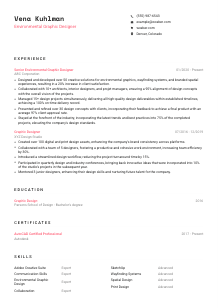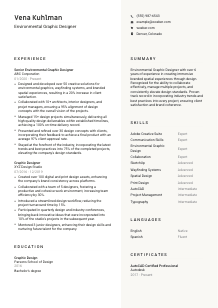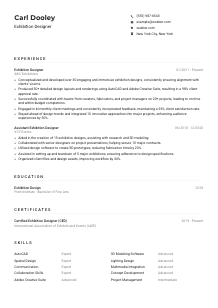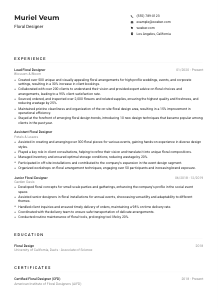Environmental Graphic Designer Resume Example
Crafting immersive spaces, but your resume design feels flat? Dive into this Environmental Graphic Designer resume example, harmonized with Wozber free resume builder. Unveil how you can seamlessly integrate your spatial storytelling skills with job criteria, positioning your career at the forefront of experiential design!
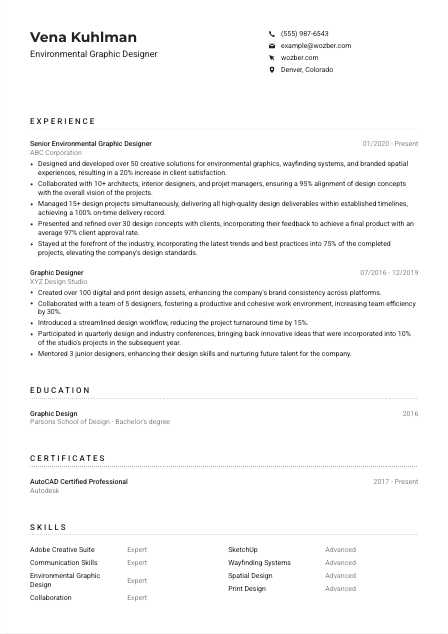
How to write an Environmental Graphic Designer Resume?
Fellow Environmental Graphic Designer, ready to elevate your resume game? In a world where your portfolio speaks volumes, your resume must sing in harmony. With Wozber free resume builder at your side, we'll guide you through crafting a resume that not only highlights your environmental graphic design prowess but also sails through the Applicant Tracking Systems (ATS) with ease. Let's dive into creating a resume that captures your unique blend of creativity and technical skill, making you an irresistible candidate for your dream role.
Personal Details
Your personal details are the gateway to your resume. It's where you make your first impression, and yes, every single detail counts. Let's make sure your contact information is as refined and targeted as your design projects.
1. Put Your Name Front and Center
Your name is your brand. Just as you'd design a logo, approach the presentation of your name with care. Use a clean, professional font that's easily readable but also conveys a sense of your design aesthetic.
2. Job Title Alignment
Immediately below your name, tailor your title to match the job you're applying for. For example, "Environmental Graphic Designer" should be prominent, reaffirming to hiring managers that you're in the right place.
3. Essential Contact Info Only
List your phone number and professional email (preferably firstname.lastname@email.com) clearly. It's your direct line to potential interviews, so double-check for accuracy.
4. Location Matters
"Must be located in Denver, Colorado" - if you meet this criteria, highlight it. Your readiness to work on-site can be a deciding factor for your candidacy.
5. Professional Website or Portfolio
Given the visual nature of your profession, including a link to your online portfolio is crucial. Ensure it's updated and reflective of your best work to date, aligning with the projects you mention in your resume.
Takeaway
Think of your personal details as the palette from which you start your masterpiece. Each element must be thoughtfully selected and presented. This section isn't just informative; it's an integral part of your personal brand.





Experience
Your experience section is your storyboard, where you tell the tale of your career through projects, collaborations, and achievements. Let's paint a vivid picture that aligns perfectly with the Environmental Graphic Designer role.
- Designed and developed over 50 creative solutions for environmental graphics, wayfinding systems, and branded spatial experiences, resulting in a 20% increase in client satisfaction.
- Collaborated with 10+ architects, interior designers, and projet managers, ensuring a 95% alignment of design concepts with the overall vision of the projects.
- Managed 15+ design projects simultaneously, delivering all high‑quality design deliverables within established timelines, achieving a 100% on‑time delivery record.
- Presented and refined over 30 design concepts with clients, incorporating their feedback to achieve a final product with an average 97% client approval rate.
- Stayed at the forefront of the industry, incorporating the latest trends and best practices into 75% of the completed projects, elevating the company's design standards.
- Created over 100 digital and print design assets, enhancing the company's brand consistency across platforms.
- Collaborated with a team of 5 designers, fostering a productive and cohesive work environment, increasing team efficiency by 30%.
- Introduced a streamlined design workflow, reducing the project turnaround time by 15%.
- Participated in quarterly design and industry conferences, bringing back innovative ideas that were incorporated into 10% of the studio's projects in the subsequent year.
- Mentored 3 junior designers, enhancing their design skills and nurturing future talent for the company.
1. Tailor Your Story
Dissect the job description to understand the core skills and projects the employer values, such as "Collaborated with architects" or "Designed wayfinding systems." Let these phrases guide your project descriptions.
2. Structured Narratives
For each role, start with your title, company name, and tenure. Present your responsibilities and projects as compelling stories that highlight your creativity and impact.
3. Highlight Key Achievements
Quantify your successes wherever possible. Did your design lead to an increase in client satisfaction? By how much? Numbers offer concrete proof of your abilities and impact.
4. Relevance is Key
Focus exclusively on experiences that speak to your capability as an Environmental Graphic Designer. Prioritize projects that resonate with the scope of work outlined in the job description.
5. Keep It Fresh
Always lead with your most recent and relevant experiences. This shows prospective employers that your skills and successes are current and transferable to their needs.
Takeaway
Craft this section as though it's your portfolio narrative. Each entry is a case study that showcases your problem-solving skills, creativity, and teamwork. Remember, it's not just about what you've done, but how you've made a difference.
Education
Even in a field where your portfolio does a lot of the talking, your educational background holds significant value. It provides context to your technical skills and design theory knowledge. Let's ensure your education section supports the narrative of your professional prowess.
1. Match the Educational Criteria
"Bachelor's degree in Graphic Design, Visual Communications, or related field" - list your relevant degree, ensuring it reflects the job requirements explicitly.
2. Clear Presentation
Maintain a tidy structure: Degree title, field of study, institution, and graduation year. This clarity helps hiring managers quickly verify your qualifications.
3. Relate Your Study to the Role
If your coursework or thesis directly relates to environmental graphic design, mention it. This provides depth to your educational achievements and shows focused dedication to your field.
4. Relevant Courses and Projects
Highlight select courses or projects that equipped you with skills particularly relevant to the job. This demonstrates your initiative to specialize early in your career trajectory.
5. Extra Mile Achievements
Did you engage in extracurricular activities or honours that are pertinent? Mentioning these showcases your passion and drive beyond the classroom.
Takeaway
Your educational background doesn't just speak to your qualifications; it narrates your journey into environmental graphic design. Let it reflect your dedication, specialization, and the breadth of your knowledge.
Certificates
In a swiftly evolving field like environmental graphic design, certifications are your heroes. They illustrate your dedication to staying ahead, mastering new tools, and refining your craft. Let's spotlight them in your resume.
1. Relevant Certifications
Prioritize showcasing certifications that are directly relevant to the role. For instance, an "AutoCAD Certified Professional" certification is highly pertinent and should be highlighted.
2. Quality over Quantity
It's better to list a few meaningful certifications than a laundry list of every course you've completed. Select certifications that bolster your proficiency and expertise in key areas mentioned in the job description.
3. Valid Dates
Ensure that your certifications are up to date, especially for software proficiency. This assures hiring managers of your current capabilities.
4. Continuous Learning
Mention any ongoing or recent courses to demonstrate your commitment to continuous professional development. It signals to employers that you're not just ready for today's challenges but are preparing for tomorrow's as well.
Takeaway
Your certifications are badges of honor, showcasing your skills and dedication to growth. Carefully select and present them as evidence of your commitment to excellence in environmental graphic design.
Skills
The skills section of your resume is where you list your professional superpowers. In the realm of Environmental Graphic Design, this means a blend of technical prowess, creative vision, and collaborative spirit. Let's ensure your skills section is as sharp as your design sense.
1. Highlight Crucial Skills
Refer back to the job description and match your skills to those requested. This tailored approach shows you're not just qualified, but an ideal match for the role.
2. Balance Technical and Soft Skills
Showcase a mix of hard skills, like "Adobe Creative Suite proficiency", and soft skills, such as "excellent interpersonal and communication skills". This rounded skill set is vital for a collaborative and creative profession.
3. Organization and Clarity
Keep your skills organized and easy to read. A bulleted list works well. Make it easy for hiring managers to see at a glance that you possess the skills needed for the job.
Takeaway
Your skill set is a dynamic inventory of your professional capabilities. Tailoring this section to the job at hand not only highlights your relevancy but also your keenness to meet the employer's specific needs.
Languages
In an increasingly globalized world, the ability to communicate across cultures is invaluable. For Environmental Graphic Designers, this can mean the difference in working with international clients or on multicultural projects. Let's articulate your linguistic dexterity.
1. Match Job Language Requirements
Start by listing languages required by the job. For instance, "must be capable in English for professional interactions" clearly prioritizes English, and it should be listed as a proficiency.
2. Showcase Your Linguistic Range
After listing the necessary language(s), add any additional languages you speak. This could set you apart in a competitive pool of candidates, especially for roles requiring international collaboration.
3. Honest Proficiency Levels
Be transparent about your level of fluency. Employers value honesty and being realistic about your language abilities ensures effective communication in their teams.
4. Cultural Insight
Multilingual abilities also hint at a broader cultural understanding, an asset in creating designs that resonate across diverse audiences. Highlight this indirect benefit of your language skills.
5. The Role's Global Scope
If the job entails working with global teams or clients, your multilingual skills become even more crucial. Make sure to emphasize how your linguistic abilities align with the job's global dimension.
Takeaway
Your language skills are a reflection of your ability to engage with the world. Highlighting these abilities can underscore your suitability for roles that require a nuanced understanding of global cultures and markets.
Summary
The summary is your professional narrative distilled into a few powerful sentences. It's where you succinctly articulate who you are, what you've achieved, and what you bring to the table. Let's craft a summary that captures the essence of your environmental graphic design expertise.
1. Reflect on Your Professional Identity
Begin by defining your professional self. Are you a creative problem-solver? A collaborative project leader? Use this self-reflection as a foundation for your summary.
2. Highlight Your Career Achievements
Pick one or two defining achievements from your career. Perhaps you designed a wayfinding system that enhanced a public space's usability. These highlights demonstrate the value you've created in past roles.
3. Address Key Competencies
Weave in skills and strengths that align with the job description. For instance, if the role emphasizes collaboration, mention your proven track record in working effectively with cross-functional teams.
4. Keep It Succinct
Aim for brevity and impact. Your summary should be a teaser that invites the hiring manager to delve deeper into your resume.
Takeaway
Your summary is the prologue to your professional story. Craft it to make a compelling case for why you're the perfect fit for the job. A well-crafted summary sets the tone for the rest of your resume and intrigues hiring managers to learn more about you.
Launching Your Environmental Graphic Designer Journey
Congratulations! You've crafted a resume that's not just a document, but a narrative of your career in Environmental Graphic Design. By aligning your resume with the specifics of your desired role and ensuring it's optimized for ATS with Wozber's ATS-friendly resume template and ATS resume scanner, you've taken a crucial step toward landing your dream job. Remember, your resume is the starting point of your professional story. Let it be dynamic, evolving as you grow in your career.
Now, with your tailored and ATS-compliant resume in hand, you're ready to step into your next big opportunity with confidence. The design world awaits your talent and vision. Go make your mark!

- Bachelor's degree in Graphic Design, Visual Communications, or related field.
- Minimum of 3 years of experience in environmental or experiential graphic design.
- Proficiency in design software such as Adobe Creative Suite, SketchUp, and AutoCAD.
- Strong portfolio showcasing a range of environmental graphic design projects.
- Excellent interpersonal and communication skills, with the ability to collaborate effectively with cross-functional teams.
- Must be capable in English for professional interactions.
- Must be located in Denver, Colorado.
- Design and develop creative solutions for environmental graphics, wayfinding systems, and branded spatial experiences.
- Collaborate with architects, interior designers, and project managers to ensure alignment of design concepts with the overall project vision.
- Manage multiple design projects simultaneously, ensuring high-quality deliverables within designated timelines.
- Present concepts and designs to clients, incorporating their feedback to refine the final product.
- Stay updated with industry trends and best practices in environmental graphic design to continuously elevate the work.





